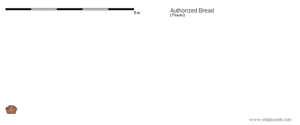Army Bread: Difference between revisions
No edit summary |
No edit summary |
||
| Line 16: | Line 16: | ||
| maxtime = | | maxtime = | ||
| served = | | served = | ||
| main_ingredient = flour | | main_ingredient = flour, water | ||
| minor_ingredient = | | minor_ingredient = yeast, sugar | ||
| variations = Mini authorized bread (1 kg) | | variations = Mini authorized bread (1 kg) | ||
| serving_size = 1 kg | | serving_size = 1 kg | ||
Latest revision as of 05:32, 14 February 2022
 | |
| Alternative names | Army bread, prison bread, Lord Dlang-men's Loaf |
|---|---|
| Type | bread |
| Course | military/prison staple rations |
| Place of origin | Themiclesia |
| Invented | 1886 |
| Main ingredients | flour, water |
| Ingredients generally used | yeast, sugar |
| Variations | Mini authorized bread (1 kg) |
| 3,130 kcal | |
The Army Bread, authorized bread, prison bread, or Lord Dlang-men's bread, is a large loaf of brown bread named for its widespread use as food rations in Themiclesian army from 1886 until 1930. In its original form, the bread weighed 5 kg and was shared between a company of five for an entire day.
Before 1886, rationing in the Themiclesian army regiments was primarily done by the quartermaster, who received a certain budget from the central government and used it to purchase ingredients locally. However, the quantity and quality of the food procured was unpredictable, and dissatisfaction was often reported in the form of food adulteration or kickbacks. The ordinary ration at that time was flour, which troops would cook into gruel, combining it with cured meat and dried vegetables, but flour was easily adulterated or the gruel "cut" with water. Lord Dlang-men, prime minister, argued that a "standard food... will reveal deficiencies, of human origin or otherwise; it takes nothing more than a scale to ensure that adequate nourishment is provided." His argument, then, was based on the idea that a finished loaf of bread was not easily adulterated or had its weight reduced; additionally, "bread keeps well and requires no container", unlike gruel which must be rapidly consumed lest it spoil, and with cutlery.
In pursuance of this goal, his government legislated in the Ordinary Rationing Act of 1886 that all quartermasters are to ensure that all enlisted men receive 1 kg of bread per day. This figure was arrived at consulting the nutritional needs of labourers, who generally received, at the employer's expense, about 1 kg of bread per working day. More food was a common incentive offered by employers in competition with each other. The same act also appointed professional bakers to positions in army regiments to provide the "authorized bread", so named because it became the only authorized rations under the law. The law specified that the flour received by the quartermasters can only come from mills under government contract and supervision, but it did not require flour of a specific grade. Thus, the flour provided by the Exchequer Department was often of the cheapest possible grade, which though not adulterated with sawdust as was often the case, was full of bran.
The common leavener was natural yeast preserved through a starter, which in literature sat in the regimental baker's pantry "like treasure". While the law does not specify what shape the bread must take, the bread was baked invariably in large, squarish ceramic moulds, giving the bread its characteristic shape. Moulds were used because otherwise the large dough would spread out under its own weight and occupy too much surface area in an oven of limited size. This is also the reason why large loaves were favoured over small loaves, because smaller loaves would be wasteful of the oven's heating surface and then dehydrate more quickly, causing the bread to become underweight. The bread usually came out of ovens in the morning and was issued after morning activities in the regiment were done. It was split and weighed in front of each enlisted man to demonstsrate that they received the established weight of bread. This became a somewhat ceremonialized affair in the army, to receive "authorized bread".
In 1889, the same procedure for procuring food was expanded to include prisons. There, the bread would be split into quarters and delivered to each prisoner, so as to preclude any opportunity whereby the bread could be removed from them.
The use of "authorized bread" continued in the army until 1930, when the government authorized more options for food procurement to enlisted persons. Themiclesia's invasion of Dzhungestan in the late 20s required a more flexible manner of food procurement and preparation in the field, as flour was difficult to procure in that country and ovens very cumbersome to transport. However, this bread would remain the army's staples into the Pan-Septentrion War, when a more diverse diet was introduced in the interest of nutrition and variety.
The "authorized bread" experienced something of a revival in the 1990s when interest in artisan baking waxed in Themiclesia. "The very idea that this is a bread designed to sustain labourers doing very hard work for an entire working day produced a mystique of wholesome nourishment about it," according to food historian Dr. Pret, "It was seen as a counter-culture to the artificial, industrially-produced white bread, though ironically the 'authorized bread' in its original usage is just about as unimaginative and industralized as the white bread of our time." Sergeant Muk stated in 2001, "If anyone were to say they miss the authorized bread, they are veritably lying. The authorized bread does its job—keeping you fed–very well and does not try to make you like it."